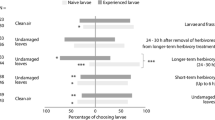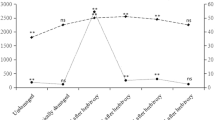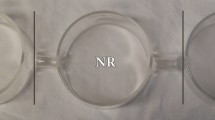Abstract
Olfaction is an important sense for many animals, yet its role in foraging by herbivores is poorly known. Many plants contain volatile compounds, such as terpenes, that are not only volatile but can be toxic if ingested. Volatile terpenes can be used by herbivores to assess leaf quality, but there is little evidence for whether they are also used as a searching cue. We applied the giving-up density (GUD) framework to examine fine-scale foraging by two free-ranging mammalian herbivores, the brush-tail possum (Trichosurus vulpecula) and the swamp wallaby (Wallabia bicolor), using patches with food and an inedible matrix that varied in content of a volatile terpene, 1,8-cineole. We tested the effect of (1) increasing dietary cineole concentration, and (2) masking the food odor by adding cineole to the inedible matrix, thus overriding the smell released by the diet. In both species GUD was affected by dietary cineole; a high cineole concentration raised GUD, consistent with its role as a toxin. There was a significant effect of masking on GUD for wallabies but not for possums, suggesting that odor was an important foraging cue at the feeding patch only for the former. Differences in ecological niche and diet may explain this pattern. We suggest that herbivores, such as the swamp wallaby, opportunistically eavesdrop on plant volatiles, i.e., take advantage of the signal proffered for a different function. The cost of this eavesdropping for plants, however, is presumably counteracted by other ecological benefits of these volatiles, including a reduction in leaf consumption as a function of toxicity.




Similar content being viewed by others
References
Acamovic T, Brooker J (2005) Biochemistry of plant secondary metabolites and their effects in animals. Proc Nutr Soc 64:403
Apfelbach R, Blanchard CD, Blanchard RJ, Hayes RA, McGregor IS (2005) The effects of predator odors in mammalian prey species: a review of field and laboratory studies. Neurosci Biobehav Rev 29:1123–1144
Boland DJ, Brophy JJ (1993) Essential oils of the eucalypts and related genera. In: Bioactive volatile compounds from plants, vol 525. American Chemical Society, pp 72–87. doi: 10.1021/bk-1993-0525.ch007
Boyle RR, McLean S (2004) Constraint of feeding by chronic ingestion of 1,8-cineole in the brushtail possum (Trichosurus vulpecula). J Chem Ecol 30:757–775. doi:10.1023/b:joec.0000028430.92739.83
Boyle R, McLean S, Foley WJ, Davies NW (1999) Comparative metabolism of dietary terpene, p-cymene, in generalist and specialist folivorous marsupials. J Chem Ecol 25:2109–2126
Boyle R, McLean S, Foley WJ, Moore BD, Davies NW, Brandon S (2000) Fate of the dietary terpene, p-cymene, in the male koala. J Chem Ecol 26:1095–1111. doi:10.1023/a:1005482207995
Brown JS (1988) Patch use as an indicator of habitat preference, predation risk, and competition. Behav Ecol Sociobiol 22:37–47. doi:10.1007/BF00395696
Campbell-Palmer R, Rosell F (2011) The importance of chemical communication studies to mammalian conservation biology: a review. Biol Conserv 144:1919–1930. doi:10.1016/j.biocon.2011.04.028
Carthey AJR, Bytheway JP, Banks PB (2011) Negotiating a noisy, information-rich environment in search of cryptic prey: olfactory predators need patchiness in prey cues. J Anim Ecol 80:742–752. doi:10.1111/j.1365-2656.2011.01817.x
Castillejos L, Calsamiglia S, Ferret A, Losa R (2005) Effects of a specific blend of essential oil compounds and the type of diet on rumen microbial fermentation and nutrient flow from a continuous culture system. Anim Feed Sci Technol 119:29–41. doi:10.1016/j.anifeedsci.2004.12.008
Chang S-T, Cheng S-S (2002) Antitermitic activity of leaf essential oils and components from Cinnamomum osmophleum. J Agric Food Chem 50:1389–1392. doi:10.1021/jf010944n
Cheng S-S, Liu J-Y, Tsai K-H, Chen W-J, Chang S-T (2004) Chemical composition and mosquito larvicidal activity of essential oils from leaves of different Cinnamomum osmophloeum provenances. J Agric Food Chem 52:4395–4400. doi:10.1021/jf0497152
Cheng S–S, Liu J-Y, Chang E-H, Chang S-T (2008) Antifungal activity of cinnamaldehyde and eugenol congeners against wood-rot fungi. Bioresour Technol 99:5145–5149. doi:10.1016/j.biortech.2007.09.013
Claridge AW, Trappe JM, Claridge DL (2001) Mycophagy by the swamp wallaby (Wallabia bicolor). Wildl Res 28:643–645. doi:10.1071/WR00105
Close D, McArthur C, Paterson S, Fitzgerald H, Walsh A, Kincade T (2003) Photo inhibition: a link between effects of the environment on eucalypt leaf chemistry and herbivory. Ecology 84:2952–2966. doi:10.1890/02-0531
Conover MR (2007) Predator-prey dynamics: the role of olfaction. CRC Press, Boca Raton
Copping LG, Duke SO (2007) Natural products that have been used commercially as crop protection agents. Pest Manage Sci 63:524–554. doi:10.1002/ps.1378
Cunningham JP, Moore CJ, Zalucki MP, West SA (2004) Learning, odour preference and flower foraging in moths. J Exp Biol 207:87–94. doi:10.1242/jeb.00733
Danks MA (2012) Gut-retention time in mycophagous mammals: a review and a study of truffle-like fungal spore retention in the swamp wallaby. Fungal Ecol 5:200–210. doi:10.1016/j.funeco.2011.08.005
Dicke M, Baldwin IT (2010) The evolutionary context for herbivore-induced plant volatiles: beyond the ‘cry for help’. Trends Plant Sci 15:167–175. doi:10.1016/j.tplants.2009.12.002
Didry N, Dubreuil L, Pinkas M (1994) Activity of thymol, carvacrol, cinnamaldehyde and eugenol on oral bacteria. Pharm Acta Helv 69:25–28. doi:10.1016/0031-6865(94)90027-2
Donaldson R, Stoddart M (1994) Detection of hypogeous fungi by Tasmanian bettong (Bettongia gaimardi: Marsupialia; Macropodoidea). J Chem Ecol 20:1201–1207. doi:10.1007/bf02059754
Duncan AJ, Milne JA (1993) Effects of oral administration of brassica secondary metabolites, allyl cyanide, allyl isothiocyanate and dimethyl disulphide, on the voluntary food intake and metabolism of sheep. Br J Nutr 70:631–645. doi:10.1079/BJN19930154
Dziba LE, Provenza FD (2008) Dietary monoterpene concentrations influence feeding patterns of lambs. Appl Anim Behav Sci 109:49–57. doi:10.1016/j.applanim.2007.02.003
Edwards PB, Wanjura WJ, Brown WV (1993) Selective herbivory by Christmas beetles in response to intraspecific variation in Eucalyptus terpenoids. Oecologia 95:551–557. doi:10.1007/BF00317440
Fedriani JM, Boulay R (2006) Foraging by fearful frugivorous: combined effect of fruit ripening and predation risk. Funct Ecol 20:1070–1079
Fey K, Banks PB, Ylönen H, Korpimäki E (2010) Behavioural responses of voles to simulated risk of predation by a native and an alien mustelid: an odour manipulation experiment. Wildl Res 37:273–282. doi:10.1071/WR08031
Foley WJ (1992) Nitrogen and energy retention and acid-base status in the common ringtail possum (Pseudocheirus peregrinus): evidence of the effects of absorbed allelochemicals. Physiol Zool 65:403–421
Foley WJ, McArthur C (1994) The effects and costs of allelochemicals for mammalian herbivores: an ecological perspective. In: Chivers DJ, Langer P (eds) The digestive system in mammals: food, form and function. Cambridge University Press, Cambridge, pp 370–391
Foley WJ, McLean S, Cork SJ (1995) Consequences of biotransformation of plant secondary metabolites on acid-base metabolism in mammals—a final common pathway? J Chem Ecol 21:721–743. doi:10.1007/bf02033457
Freeland WJ, Janzen DH (1974) Strategies in herbivory by mammals: the role of plant secondary compounds. Am Nat 108:269. doi:10.1086/282907
Freeland WJ, Winter JW (1975) Evolutionary consequences of eating: Trichosurus vulpecula (marsupialia) and the genus Eucalyptus. J Chem Ecol 1:439–455. doi:10.1007/BF00988585
Hădărugă NG, Branic AG, Hădărugă DI, Gruia A, Pleşa C, Costescu C, Ardelean A, Lupea AX (2011) Comparative study of Juniperus communis and Juniperus virginiana essential oil: TLC and GC analysis. J Planar Chromatogr-Mod TLC 24:130–135. doi:10.1556/JPC.24.2011.2.9
Hamish Cochrane C, Norton DA, Miller CJ, Allen RB (2003) Brushtail possum (Trichosurus vulpecula) diet in a north Westland mixed-beech (Nothofagus) forest. N Z J Ecol 27:61–65
Harper MJ (2005) Home range and den use of common brushtail possums (Trichosurus vulpecula) in urban forest remnants. Wildl Res 32:681–687. doi:10.1071/WR04072
Haynes KF, Yeargan KV (1999) Exploitation of intraspecific communication systems: illicit signalers and receivers. Ann Entomol Soc Am 92:960–970
Hochman V, Kotler BP (2007) Patch use, apprehension, and vigilance behavior of Nubian Ibex under perceived risk of predation. Behav Ecol 18:368–374. doi:10.1093/beheco/arl087
Hollis C, Robertshaw J, Harden R (1986) Ecology of the swamp wallaby (Wallabia bicolor) in northeastern New South Wales. I. Diet. Wildl Res 13:355–365. doi:10.1071/WR9860355
Hooth MJ, Sills RC, Burka LT, Haseman JK, Witt KL, Orzech DP, Fuciarelli AF, Graves SW, Johnson JD, Bucher JR (2004) Toxicology and carcinogenesis studies of microencapsulated trans-cinnamaldehyde in rats and mice. Food Chem Toxicol 42:1757–1768. doi:10.1016/j.fct.2004.07.002
Hoskins JA (1984) The occurrence, metabolism and toxicity of cinnamic acid and related compounds. J Appl Toxicol 4:283–292. doi:10.1002/jat.2550040602
Huang Y, Ho SH (1998) Toxicity and antifeedant activities of cinnamaldehyde against the grain storage insects, Tribolium castaneum (Herbst) and Sitophilus zeamais Motsch. J Stored Prod Res 34:11–17. doi:10.1016/S0022-474X(97)00038-6
Hughes NK, Price CJ, Banks PB (2010) Predators are attracted to the olfactory signals of prey. PLoS ONE 5:e13114. doi:10.1371/journal.pone.0013114
Hulley IM, Viljoen AM, Tilney PM, Van Vuuren SF, Kamatou GPP, Van Wyk BE (2010) The ethnobotany, leaf anatomy, essential oil variation and biological activity of Pteronia incana (Asteraceae). S Afr J Bot 76:668–675. doi:10.1016/j.sajb.2010.08.007
Hume ID (1999) Marsupial nutrition. Cambridge University Press, Melbourne
Kim H-K, Kim J-R, Ahn Y-J (2004) Acaricidal activity of cinnamaldehyde and its congeners against Tyrophagus putrescentiae (Acari: Acaridae). J Stored Prod Res 40:55–63. doi:10.1016/S0022-474X(02)00075-9
Kirmani SN, Banks PB, McArthur C (2010) Integrating the costs of plant toxins and predation risk in foraging decisions of a mammalian herbivore. Oecologia 164:349–356. doi:10.1007/s00442-010-1717-y
Kotler BP, Brown JS, Hasson O (1991) Factors affecting gerbil foraging behavior and rates of owl predation. Ecology 72:2249–2260
Kotler BP, Brown JS, Hickey M (1999) Food storability and the foraging behavior of fox squirrels (Sciurus niger). Am Midl Nat 142:77–86. doi:10.1674/0003-0031(1999)142
Kyriazakis I, Anderson DH, Duncan AJ (1998) Conditioned flavour aversions in sheep: the relationship between the dose rate of a secondary plant compound and the acquisition and persistence of aversions. Br J Nutr 79:55–62. doi:10.1079/Bjn19980009
Laska M (1990) Olfactory discrimination ability in short-tailed fruit bat, Carollia perspicillata (Chiroptera: Phyllostomatidae). J Chem Ecol 16:3291–3299. doi:10.1007/bf00982099
Launchbaugh KL, Provenza FD (1993) Can plants practice mimicry to avoid grazing by mammalian herbivores? Oikos 66:501–504. doi:10.2307/3544945
Lawler IR, Stapley J, Foley WJ, Eschler BM (1999) Ecological example of conditioned flavor aversion in plant–herbivore interactions: effect of terpenes of Eucalyptus leaves on feeding by common ringtail and brush tail possums. J Chem Ecol 25:401–415. doi:10.1023/A:1020863216892
Lawler IR, Foley WJ, Eschler BM (2000) Foliar concentration of a single toxin creates habitat patchiness for a marsupial folivore. Ecology 81:1327–1338. doi:10.1890/0012-9658(2000)081
Loney PE, McArthur C, Sanson GD, Davies NW, Close DC, Jordan GJ (2006) How do soil nutrients affect within-plant patterns of herbivory in seedlings of Eucalyptus nitens? Oecologia 150:409–420. doi:10.1007/s00442-006-0525-x
Low PA (2011) Insects eating Eucalypts: a highly volatile situation? Direct and indirect effects of host plant quality on eucalypt-feeding insect herbivores. In: School of biological sciences, vol. Bachelor of Science (Advanced) with Honours. University of Sydney, Sydney
MacLennan DG (1984) The feeding behaviour and activity patterns of the brush tail possum, Trichosurus vulpecula, in an open eucalypt woodland in southeast Queensland. In: Smith A, Hume ID (eds) Possums and gliders. S. Beatty in association with the Australian Mammal Society, Sydney, pp 155–161
Marsh KJ, Wallis IR, McLean S, Sorensen JS, Foley WJ (2006) Conflicting demands on detoxification pathways influence how common brushtail possums choose their diets. Ecology 87:2103–2112. doi:10.1890/0012-9658(2006)87
Mattiacci L, Dicke M, Posthumus MA (1995) β-Glucosidase: an elicitor of herbivore-induced plant odor that attracts host-searching parasitic wasps. Proc Nat Acad Sci 92:2036–2040
May MD, Bowen MT, McGregor IS, Timberlake W (2012) Rubbings deposited by cats elicit defensive behavior in rats. Physiol Behav 107:711–718. doi:10.1016/j.physbeh.2012.03.007
McArthur C, Bradshaw Oliver S, Jordan Gregory J, Clissold Fiona J, Pile Adele J (2010) Wind affects morphology, function, and chemistry of eucalypt tree seedlings. Int J Plant Sci 171:73–80
McArthur C, Orlando P, Banks PB, Brown JS (2012) The foraging tightrope between predation risk and plant toxins: a matter of concentration. Funct Ecol 26:74–83. doi:10.1111/j.1365-2435.2011.01930.x
McGarvey DJ, Croteau R (1995) Terpenoid metabolism. Plant Cell 7:1015–1026. doi:10.2307/3870054
McLean S, Foley WJ (1997) Metabolism of Eucalyptus terpenes by herbivorous marsupials. Drug Metab Rev 29:213–218. doi:10.3109/03602539709037582
Miller AM, McArthur C, Smethurst PJ (2006) Characteristics of tree seedlings and neighbouring vegetation have an additive influence on browsing by generalist herbivores. For Ecol Manage 228:197–205. doi:10.1016/j.foreco.2006.03.003
Miller AM, McArthur C, Smethurst PJ (2007) Effects of within-patch characteristics on the vulnerability of a plant to herbivory. Oikos 116:41–52. doi:10.1111/j.2006.0030-1299.15331.x
Montague TL, Pollock DC, Wright W (1990) An examination of the browsing animal problem in australian eucalypt and pine plantations. In: Vertebrate Pest Conference Proceedings collection. DigitalCommons@ University of Nebraska—Lincoln, University of Nebraska, Lincoln, pp 203–208
O’Reilly-Wapstra J, McArthur C, Potts B (2002) Genetic variation in resistance of Eucalyptus globulus to marsupial browsers. Oecologia 130:289–296. doi:10.1007/s004420100797
O’Reilly-Wapstra JM, McArthur C, Potts BM (2004) Linking plant genotype, plant defensive chemistry and mammal browsing in a Eucalyptus species. Funct Ecol 18:677–684. doi:10.1111/j.0269-8463.2004.00887.x
O’Reilly-Wapstra JM, Potts BM, McArthur C, Davies NW, Tilyard P (2005) Inheritance of resistance to mammalian herbivores and of plant defensive chemistry in an Eucalyptus species. J Chem Ecol 31:357–375
Pallini A, Janssen A, Sabelis MW (1997) Odour-mediated responses of phytophagous mites to conspecific and heterospecific competitors. Oecologia 110:179–185. doi:10.1007/s004420050147
Penfold AR (1948) The volatile oils of the australian flora. Australian and New Zealand Association for the Advancement of Science, Tasmania
Plepys D, Ibarra F, Francke W, Löfstedt C (2002) Odour-mediated nectar foraging in the silver Y moth, Autographa gamma (Lepidoptera: Noctuidae): behavioural and electrophysiological responses to floral volatiles. Oikos 99:75–82. doi:10.1034/j.1600-0706.2002.990108.x
Price CJ, Banks PB (2012) Exploiting olfactory learning in alien rats to protect birds’ eggs. Proc Natl Acad Sci 109:19304–19309. doi:10.1073/pnas.1210981109
Provenza FD, Kimball BA, Villalba JJ (2000) Roles of odor, taste, and toxicity in the food preferences of lambs: implications for mimicry in plants. Oikos 88:424–432. doi:10.1034/j.1600-0706.2000.880220.x
Pyare S, Longland WS (2001) Mechanisms of truffle detection by northern flying squirrels. Can J Zool 79:1007–1015. doi:10.1139/z01-069
Quinn GP, Keough MJ (2009) Experimental design and data analysis for biologists. Cambridge University Press, Cambridge
Sánchez F, Korine C, Steeghs M, Laarhoven L-J, Cristescu S, Harren FM, Dudley R, Pinshow B (2006) Ethanol and methanol as possible odor cues for Egyptian fruit bats (Rousettus aegyptiacus). J Chem Ecol 32:1289–1300. doi:10.1007/s10886-006-9085-0
Schmidt KA, Brown JS, Morgan RA (1998) Plant defenses as complementary resources: a test with squirrels. Oikos 81:130–142
Sharkey TD, Chen X, Yeh S (2001) Isoprene increases thermo tolerance of fosmidomycin-fed leaves. American Society of Plant Biologists, Rockville
Southwell IA, Maddox CDA, Zalucki MP (1995) Metabolism of 1,8-cineole in tea tree (Melaleuca alternifolia and M. linariifolia) by pyrgo beetle (Paropsisterna tigrina). J Chem Ecol 21:439–453. doi:10.1007/bf02036741
Stowe MK, Turlings TC, Loughrin JH, Lewis WJ, Tumlinson JH (1995) The chemistry of eavesdropping, alarm, and deceit. Proc Natl Acad Sci 92:23–28
Takabayashi J, Dicke M (1996) Plant—carnivore mutualism through herbivore-induced carnivore attractants. Trends Plant Sci 1:109–113. doi:10.1016/s1360-1385(96)90004-7
Thomas J, Benson D (1985) Vegetation survey of Ku-ring-gai chase National Park. Report to NSW National Parks and Wildlife Service. Royal Botanic Gardens, Sydney
Tronson D (2001) The odour, the animal and the plant. Molecules 6:104–116
Vander Wall SB (1998) Foraging success of granivorous rodents: effects of variation in seed and soil water on olfaction. Ecology 79:233–241. doi:10.1890/0012-9658(1998)079
Wiggins NL, McArthur C, McLean S, Boyle R (2003) Effects of two plant secondary metabolites, cineole and gallic acid, on nightly feeding patterns of the common brush tail possum. J Chem Ecol 29:1447–1464. doi:10.1023/A:1024221705354
Yearsley JM, Villalba JJ, Gordon IJ, Kyriazakis I, Speakman JR, Tolkamp BJ, Illius AW, Duncan AJ (2006) A theory of associating food types with their postingestive consequences. Am Nat 167:705–716. doi:10.1086/502805
Zidar J, Løvlie H (2012) Scent of the enemy: behavioural responses to predator faecal odour in the fowl. Anim Behav 84:547–554. doi:10.1016/j.anbehav.2012.06.006
Acknowledgments
This research was funded by an Australian Research Council grant to C. M. and P. B. B. (ARC-DP0877585), with the approval of the University of New South Wales Animal Care and Ethics Committee (ACEC) (nos. 08/75B and 11/89A), and permits from Nationals Parks and Wildlife Service (S12371 and SL100443). We thank Basil Panayotakos for help in the design and construction of feeders.
Author information
Authors and Affiliations
Corresponding author
Additional information
Communicated by Joanna Lambert.
Rights and permissions
About this article
Cite this article
Bedoya-Pérez, M.A., Isler, I., Banks, P.B. et al. Roles of the volatile terpene, 1,8-cineole, in plant–herbivore interactions: a foraging odor cue as well as a toxin?. Oecologia 174, 827–837 (2014). https://doi.org/10.1007/s00442-013-2801-x
Received:
Accepted:
Published:
Issue Date:
DOI: https://doi.org/10.1007/s00442-013-2801-x




